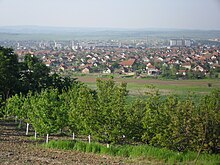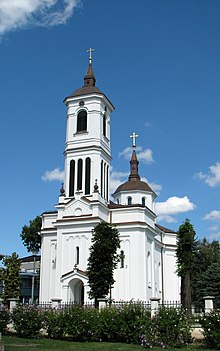Kladovo
|
Кладово Kladovo |
||||
|
||||
| Basic data | ||||
|---|---|---|---|---|
| State : | Serbia | |||
| Okrug : | boron | |||
| Opština : | Kladovo | |||
| Coordinates : | 44 ° 36 ' N , 22 ° 37' E | |||
| Residents : | 9,142 (2002) | |||
| Telephone code : | (+381) 019 | |||
| Postal code : | 19320 | |||
| License plate : | Kl | |||
| Structure and administration | ||||
| Community type: | city | |||
| Website : | ||||
| Others | ||||
| City Festival : | Etno Festival Kladovo | |||
Kladovo ( Serbian Kladovo / Кладово) is a town in the Opština Kladovo and in the Bor district . It is the administrative capital of the municipality of the same name.
Surname
In Serbian the city is called Kladovo , in Romanian it is known as Claudia .
During the time of the Roman Empire the city was called Zanes . After that, Slavs called the city Novi Grad ("New City"). The Ottomans built the fortress Fetislam on the current location of the city . The city with its current name Kladovo first appeared on Austro-Hungarian maps in 1596.
history
In ancient times, a city called Zanes existed at the current location of that city. In the Middle Ages , the Serbs founded the city of Novi Grad (Нови Град) on its current location, but this city was destroyed by the Hungarians in 1502 . The city rebuilt by the Ottomans in 1524 , and it was named Fethi Islam (Fetislam). According to the Ottoman traveler Evliya Cheleb , who visited the city in 1666 , most of the people there spoke the regional Slavic language, but some people also spoke Wallachian (Romanian).
In 1784 there were 140 Muslim and 50 Christian houses. After the fall of the Ottoman Empire , people from central Serbian areas moved to the city.
Before the Đerdap hydropower plant was built in the immediate vicinity of the city, the city was a small village, but it grew rapidly after the power plant was built.
Geography and tourism
Due to the many archaeological sites in the area and the Đerdap hydroelectric power station, there are many attractions for tourists . The city is surrounded by the Danube to the north and northeast, and by a series of low mountains to the south, west and south.
Residents
The 2002 census (self-named) showed that 9142 people live in the village. Other censuses:
- 1948: 2.128
- 1953: 2,336
- 1961: 2,683
- 1971: 6,957
- 1981: 8.325
- 1991: 9,626
economy
The core business is the "Đerdap" hydropower plant. The population around the city receives money from so-called "guest workers". These are family members who work abroad, particularly Western Europe. Along with agriculture, this factor is the most important in the entire municipality .
Others
Kladovo has a hospital, two day-care centers and kindergarten centers, a primary school (grades 1 to 8), a grammar school and several vocational schools. Although the Danube is very polluted, many people still catch fish in it. Before the hydroelectric power station was built, the sturgeon and caviar were exported as delicacies to Western Europe and the United States of America.
The archaeological sites nearby are the remains of the Roman Emperor Trajan, as well as one of his many tables, remains of the Trajan Street across the Danube and the Roman fortress "Diana". The Serbian Orthodox Church of St. George was built from 1856 to 1862 .
During the Ottoman occupation of the Balkan Peninsula, a fortress was built near the city. The fortress Fetislam (originally Feht-ul-Islam, means "Gate of Islam") was converted into a sports complex with children's playgrounds, athletics and football, handball, volleyball and tennis fields in 1970. The national park offers hunting areas and many hiking trails (most of the trails are well marked or not maintained).
The city has a hotel called "Đerdap" and a youth camp called "Karataš" (Turkish: kara-tash, in German this means "black stone"). Kladovo has many cafes and restaurants, some with live music until late at night. The city stretches for 3 kilometers (2 miles) along the Danube and offers very beautiful scenery to stroll through.
Famous houses
A famous residence is that of Vuk Stefanović Karadžić , a Serbian linguist and reformer of the Serbian language.
coat of arms
Former small coat of arms in the SFR Yugoslavia
swell
- ↑ Overall result of the census of April 2002 (English) ( Memento of March 6, 2009 in the Internet Archive ) (PDF; 379 kB)








